Found in a filing box in my parents' house
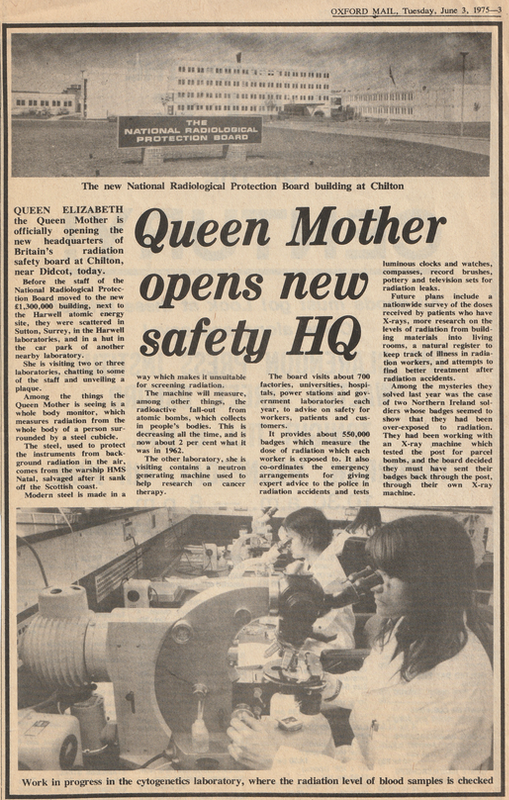
Text: QUEEN ELIZABETH the Queen Mother is officially opening the new headquarters of Britain's radiation safety board at Chilton near Didcot, today.
Before the staff of the National Radiological Protection Board moved to the new £1,300,000 building, next to the Harwell atomic energy site, they were scattered in Sutton, Surrey, in the Harwell laboratories, and in a hut in the car park of another nearby laboratory.
She is visiting two or three laboratories, chatting to some of the staff and unveiling a plaque.
Among the things the Queen Mother is seeing is a whole body monitor, which measures radiation from the whole body of a person surrounded by a steel cubicle.
The steel, used to protect the instruments from background radiation in the air, comes from the warship HMS Natal, salvaged after it sank off the Scottish coast.
Modern steel is made in a way which makes it unsuitable for screening radiation.
The machine will measure, among other things, the radioactive fall-out from atomic bombs, which collects in people's bodies. This is decreasing all the time, and is now about 2 per cent what it was in 1962.
The other laboratory, she is visiting contains a neutron generating machine used to help research on cancer therapy.
The board visits about 700 factories, universities, hospitals, power stations and government laboratories each year, to advise on safety for workers, patients and customers.
It provides about 550,000 badges which measure the dose of radiation which each worker is exposed to. It also coordinates the emergency arrangements for giving expert advice to the police in radiation accidents, and tests luminous clocks and watches, compasses, record brushes, pottery and television sets for radiation leaks.
Future plans include a nationwide survey of the doses received by patients who have X-rays, more research on the levels of radiation from buliding materials into living rooms, a natural register to keep track of illness in radiation workers, and attempts to find better treatment after radiation accidents.
Among the mysteries they solved last year was the case of two Northern Ireland soldiers whose badges seemed to show that they had been over-exposed to radiation. They had been working with an X-ray machine which tested the post for parcel bombs, and the board decided they must have sent their badges back through the post, through their own X-ray machine.
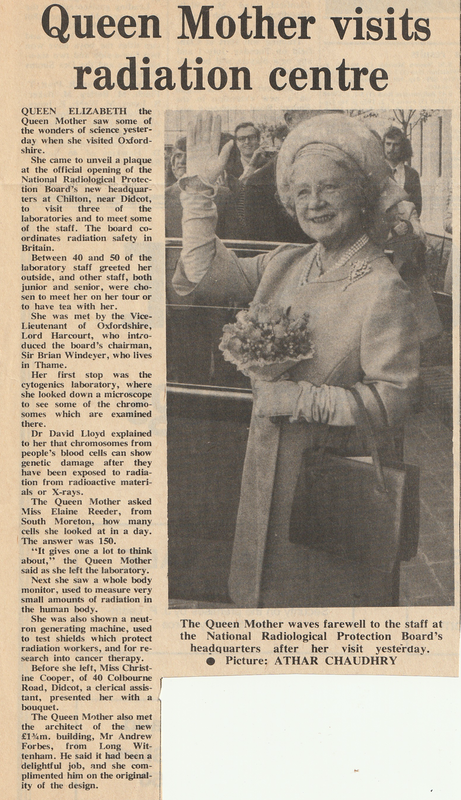
Text: QUEEN ELIZABETH the Queen Mother saw some of the wonders of science yesterday when she visited Oxfordshire.
She came to unveil a plaque at the official opening of the National Radiological Protection Board's new headquarters at Chilton, near Didcot, to visit three of the laboratories and to meet some of the staff. The board coordinates radiation safety in Britain.
Between 40 and 50 of the laboratory staff greeted her outside, and other staff, both junior and senior, were chosen to meet her on her tour or to have tea* with her.
She was met by the Vice-Lieutenant of Oxfordshire, Lord Harcourt, who introduced the board's chaiman, Sir Brian Windeye, who lives in Thame.
Her first stop was the cytogenics laboratory, where she looked down a microscope to see some of the chromosomes which are examined there.
Dr David Lloyed explained to her that chromosomes from people's blood cells can show genetic damage after they have been exposed to radiation from radioactive material or X-rays.
The Queen Mother asked Miss Elaine Reeder, from South Moreton, how many cells she looked at in a day. The answer was 150.
"It gives one a lot to think about," the Queen Mother said as she left the laboratory.
Next she saw a whole body monitor, used to measure very small amounts of radiation in the human body.
She was also shown a neutron generating machine, used to test shields which protect radiation workers, and for research into cancer therapy.
Before she left, Miss Christine Cooper, of 40 Colbourne Road, Didcot, a clerical assistant, presented her with a bouquet.
The Queen Mother also met the architect of the new £1 3/4m building, Mr Andrew Forbes, from Long Wittenham. He said it had been a delightful job, and she complimented him on the originality of the design.
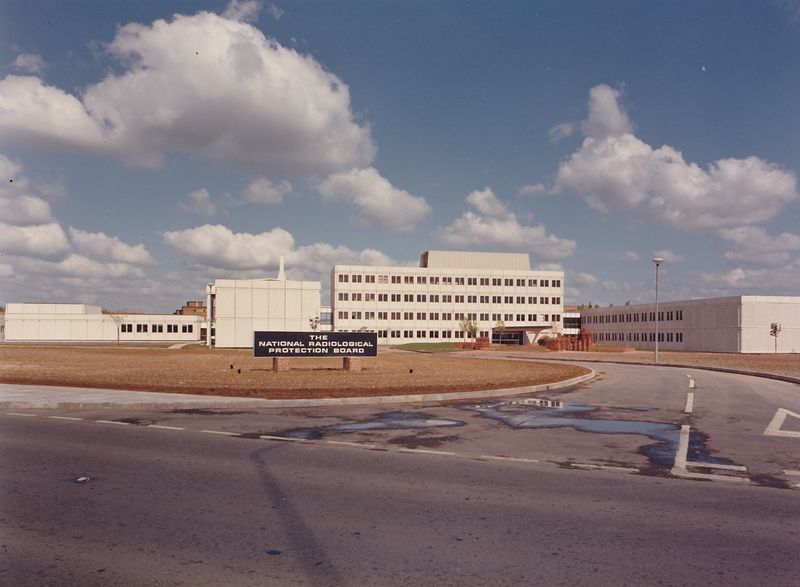
I feel that the Queen Mother was heroically reaching for a truthful adjective when describing this is an original design. My memory is it was a little less square in reality. I think it starred in several Blakes' 7 episodes - all those ones where the crew of the liberator are running around vast empty factories...
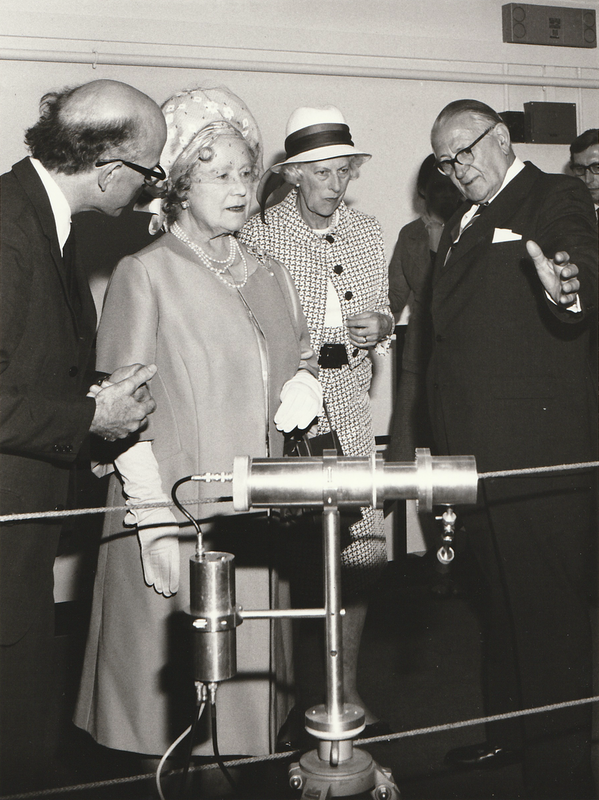
The bald man in these photos is my Dad. Consensus of opinion in this household is that the cylindrical thing must be a neutron generator - if only because it clearly isn't a microscope or a whole body monitor.
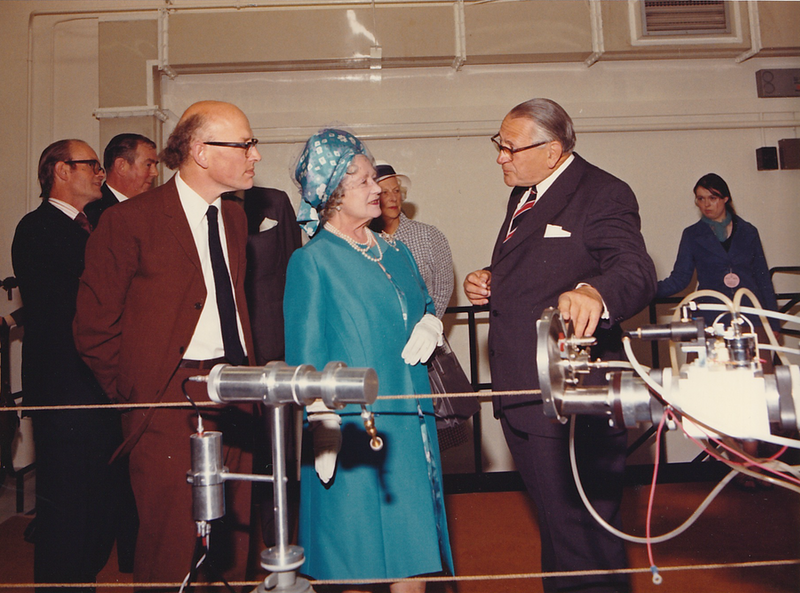
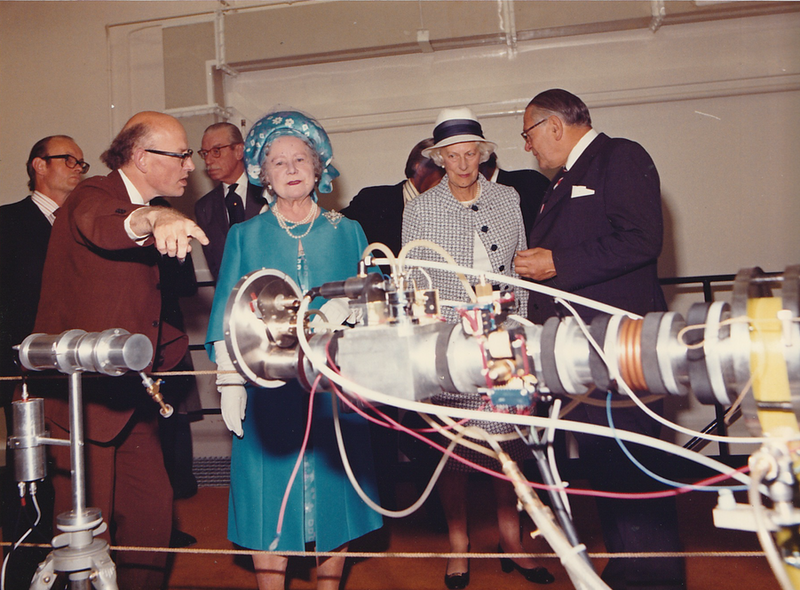
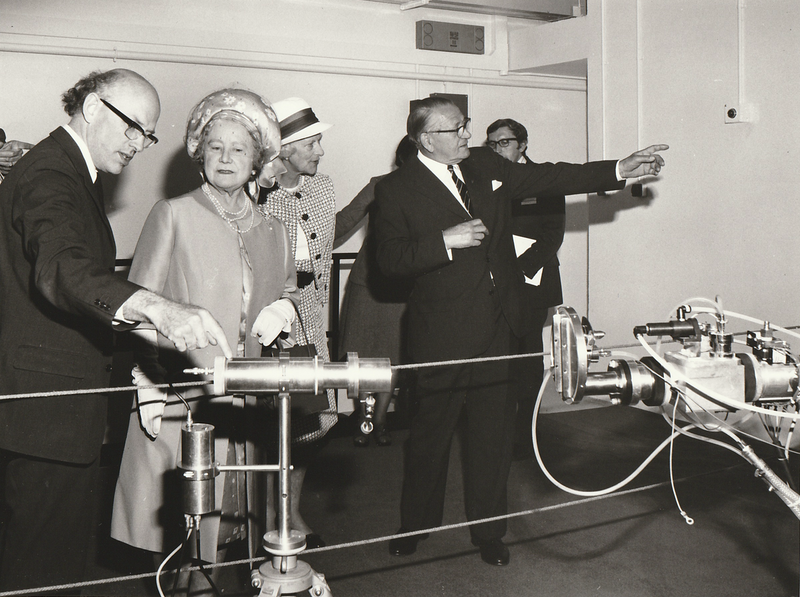
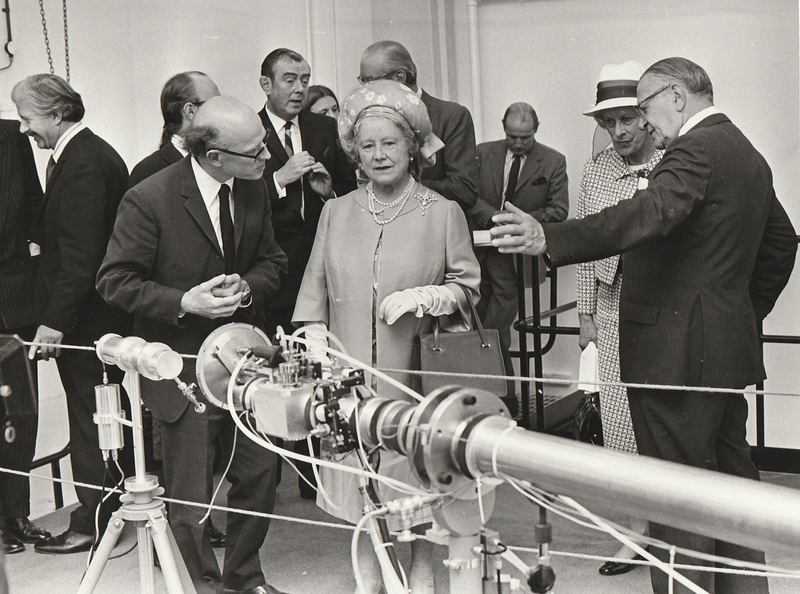
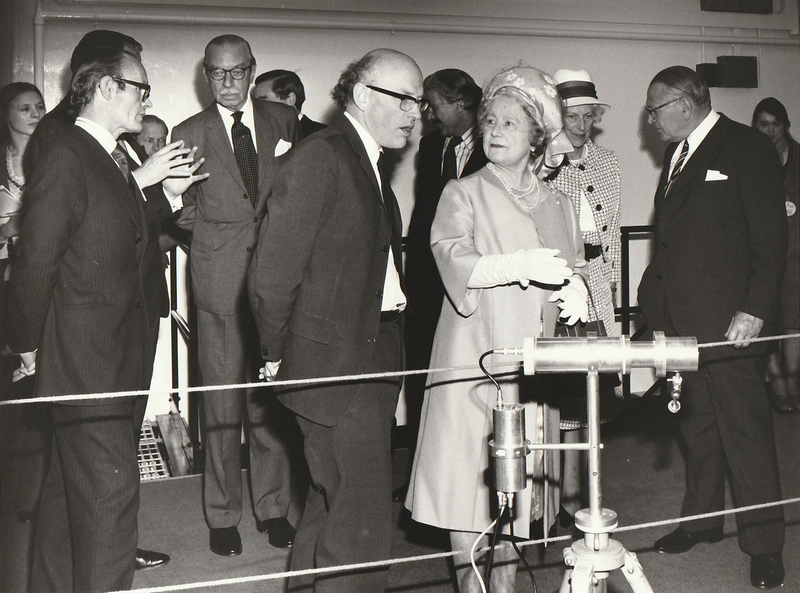
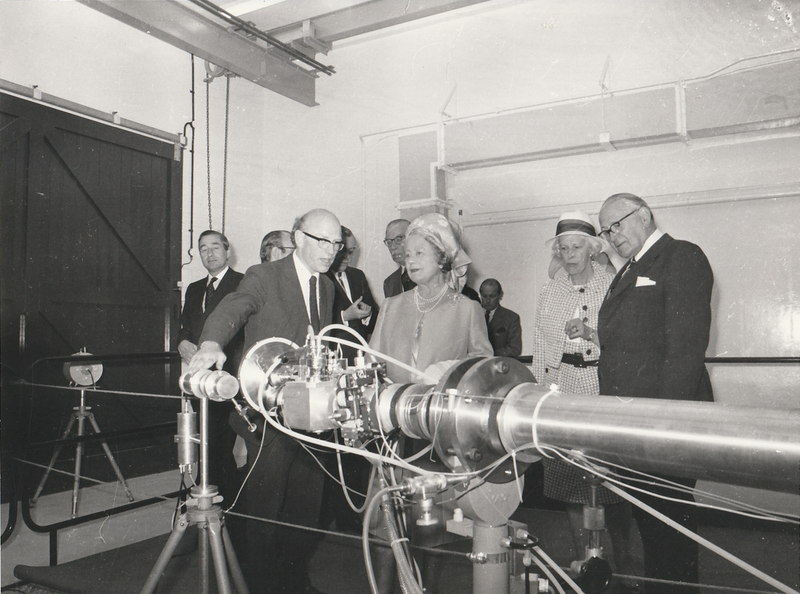
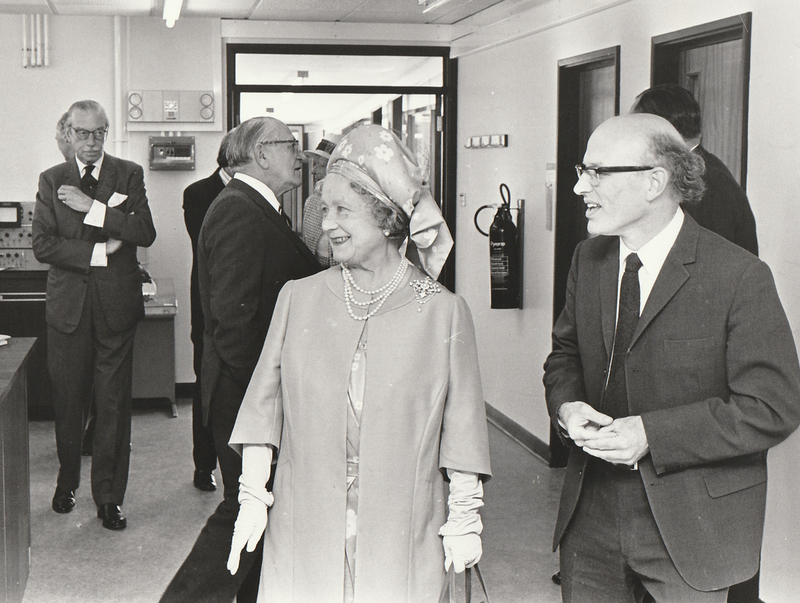
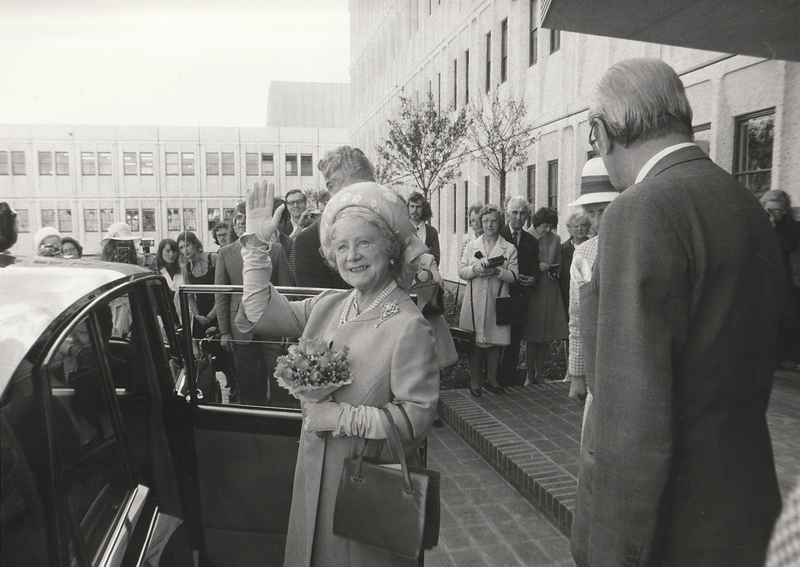
* Family legend states that when inquired as to what sort of beverage should be supplied for "tea", they were told that the Queen Mum favoured gin.

Text: QUEEN ELIZABETH the Queen Mother is officially opening the new headquarters of Britain's radiation safety board at Chilton near Didcot, today.
Before the staff of the National Radiological Protection Board moved to the new £1,300,000 building, next to the Harwell atomic energy site, they were scattered in Sutton, Surrey, in the Harwell laboratories, and in a hut in the car park of another nearby laboratory.
She is visiting two or three laboratories, chatting to some of the staff and unveiling a plaque.
Among the things the Queen Mother is seeing is a whole body monitor, which measures radiation from the whole body of a person surrounded by a steel cubicle.
The steel, used to protect the instruments from background radiation in the air, comes from the warship HMS Natal, salvaged after it sank off the Scottish coast.
Modern steel is made in a way which makes it unsuitable for screening radiation.
The machine will measure, among other things, the radioactive fall-out from atomic bombs, which collects in people's bodies. This is decreasing all the time, and is now about 2 per cent what it was in 1962.
The other laboratory, she is visiting contains a neutron generating machine used to help research on cancer therapy.
The board visits about 700 factories, universities, hospitals, power stations and government laboratories each year, to advise on safety for workers, patients and customers.
It provides about 550,000 badges which measure the dose of radiation which each worker is exposed to. It also coordinates the emergency arrangements for giving expert advice to the police in radiation accidents, and tests luminous clocks and watches, compasses, record brushes, pottery and television sets for radiation leaks.
Future plans include a nationwide survey of the doses received by patients who have X-rays, more research on the levels of radiation from buliding materials into living rooms, a natural register to keep track of illness in radiation workers, and attempts to find better treatment after radiation accidents.
Among the mysteries they solved last year was the case of two Northern Ireland soldiers whose badges seemed to show that they had been over-exposed to radiation. They had been working with an X-ray machine which tested the post for parcel bombs, and the board decided they must have sent their badges back through the post, through their own X-ray machine.

Text: QUEEN ELIZABETH the Queen Mother saw some of the wonders of science yesterday when she visited Oxfordshire.
She came to unveil a plaque at the official opening of the National Radiological Protection Board's new headquarters at Chilton, near Didcot, to visit three of the laboratories and to meet some of the staff. The board coordinates radiation safety in Britain.
Between 40 and 50 of the laboratory staff greeted her outside, and other staff, both junior and senior, were chosen to meet her on her tour or to have tea* with her.
She was met by the Vice-Lieutenant of Oxfordshire, Lord Harcourt, who introduced the board's chaiman, Sir Brian Windeye, who lives in Thame.
Her first stop was the cytogenics laboratory, where she looked down a microscope to see some of the chromosomes which are examined there.
Dr David Lloyed explained to her that chromosomes from people's blood cells can show genetic damage after they have been exposed to radiation from radioactive material or X-rays.
The Queen Mother asked Miss Elaine Reeder, from South Moreton, how many cells she looked at in a day. The answer was 150.
"It gives one a lot to think about," the Queen Mother said as she left the laboratory.
Next she saw a whole body monitor, used to measure very small amounts of radiation in the human body.
She was also shown a neutron generating machine, used to test shields which protect radiation workers, and for research into cancer therapy.
Before she left, Miss Christine Cooper, of 40 Colbourne Road, Didcot, a clerical assistant, presented her with a bouquet.
The Queen Mother also met the architect of the new £1 3/4m building, Mr Andrew Forbes, from Long Wittenham. He said it had been a delightful job, and she complimented him on the originality of the design.

I feel that the Queen Mother was heroically reaching for a truthful adjective when describing this is an original design. My memory is it was a little less square in reality. I think it starred in several Blakes' 7 episodes - all those ones where the crew of the liberator are running around vast empty factories...

The bald man in these photos is my Dad. Consensus of opinion in this household is that the cylindrical thing must be a neutron generator - if only because it clearly isn't a microscope or a whole body monitor.








* Family legend states that when inquired as to what sort of beverage should be supplied for "tea", they were told that the Queen Mum favoured gin.
(no subject)
Date: 2025-01-30 07:39 pm (UTC)(no subject)
Date: 2025-01-30 09:09 pm (UTC)(no subject)
Date: 2025-01-31 03:58 am (UTC)(no subject)
Date: 2025-02-01 11:16 am (UTC)(no subject)
Date: 2025-01-31 07:49 pm (UTC)(no subject)
Date: 2025-02-01 11:17 am (UTC)